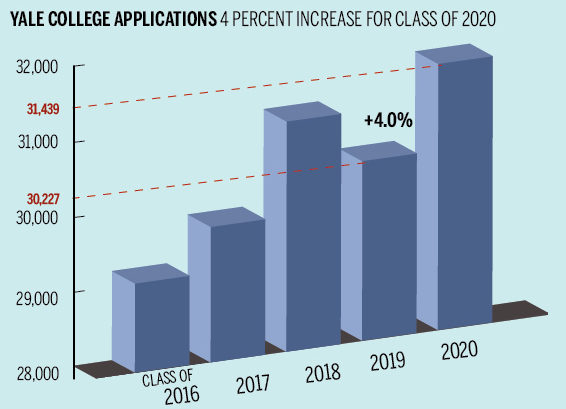
Yale has received 31,439 total applications for the class of 2020 — the highest number submitted for any individual class in University history.
The number of applications surpassed the 31,000 mark for the first time ever, exceeding the previous record of 30,922 applications for the class of 2018. While the number of early action applications remained relatively stable this year at around 4,700 — the same as last year — applications to the class of 2020 overall are up by 1,132 from the last admissions cycle.
Despite the increase, Dean of Undergraduate Admissions Jeremiah Quinlan said Yale values the overall quality of the applicant pool rather than sheer quantity of applications received.
“The goal is not to get more applications, but we’re always happy to see such strong interest in Yale College,” Quinlan said. “It’s more important to have the right 30,000 applications than to get more than 30,000, and I think there was some really positive growth in the applicant pool.”
Quinlan also noted that long-term trends in application data are more important than minor fluctuations from year to year. This year’s application numbers represent a 49 percent increase from the 21,101 applications Yale received for the class of 2009, he said. Quinlan attributed the massive increase to greater mobility of top secondary school students and technological changes to the admissions process, like more widespread use of the online Common Application.
Quinlan added that a goal for next year will be to continue raising awareness of Yale’s affordability among prospective students.
In addition to the overall increase in the regular applicant pool, the University also saw a 10 percent increase in applications from students identifying as African-American. Quinlan declined to specify the total number of applicants of that cohort, as it has traditionally been the University’s policy not to release that information.
The rise in applications from African-Americans is part of a long-standing trend of increasing minority student interest in Yale. Since 2013, the number of applications from African-American students has increased by 36 percent. For students who identify as members of a minority racial or ethnic group, that number has increased 18 percent in the same period. By comparison, the total number of applications from high school students in the United States has risen by 5 percent.
But Director of Outreach and Recruitment Mark Dunn ’07 said it is impossible to attribute an increase in applications — either overall or from a specific group — to one particular outreach strategy. However, he said the increasing diversity of the applicant pool aligns with Yale’s outreach philosophy, which focuses on reaching communities where students have not typically considered schools like Yale. Efforts to increase the diversity of the applicant pool include the Yale Ambassadors program, which sends current students to high schools to speak with standout students from disadvantaged socioeconomic backgrounds, and the Multicultural Open House, which invites students and their families to campus to learn about Yale’s academic and cultural offerings.
“One of the most important messages we share is that Yale’s close-knit and supportive communities are strengthened by their diversity,” Dunn said. “And more than anything, I think, it is these communities that draw prospective students to Yale.”
Despite a turbulent fall semester which saw campus demonstrations over complaints of a hostile racial atmosphere at Yale, students interviewed said they were not surprised to hear of the large increase in applications from African-Americans, as well as overall.
“I think that students of color and students who are on the liberal side of the spectrum saw the inherent problems on campus and the demonstrations that students at Yale underwent and saw it as a sign that Yale was a place that encouraged student activism and that students were proactive about creating an environment where they could thrive and feel at home,” said Isaac Scobey-Thal ’19.
Sam Bowers ’18 agreed that the turmoil would actually be positive for Yale. He said the dialogue on campus was a sign that there is work in progress to make the campus more welcoming and that there is an opportunity for students to make a difference by bringing about that change themselves.
Scobey-Thal added that the steps taken by University President Peter Salovey to address the situation — which included increased funding to the cultural centers, increased mental health resources for students of color and reforms to financial aid — likely made the University even more attractive for minority applicants.
“What happened in the fall exposed issues on campus, but it also showed that we had a student body who was willing to fight for what they believed in,” Ree Ree Li ’16 said.
Li added that increased administrative support for ethnic studies courses and the promulgation of “teach-ins” — educational events where students can learn about issues related to race and ethnicity — could have contributed to a more favorable view of Yale.
The University of Pennsylvania also received a record number of applications for its class of 2020, up 4 percent since last year to 38,792. Other Ivy League schools have not yet made their application data publicly available.
Admissions decisions for the Yale class of 2020 will be released on March 31 along with those from the other Ivy League schools.







